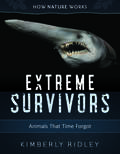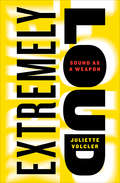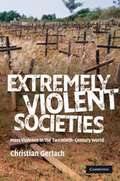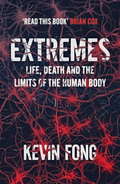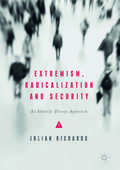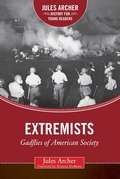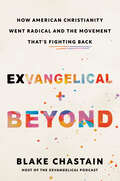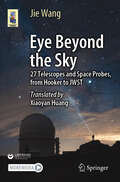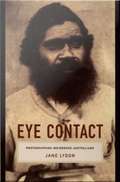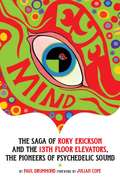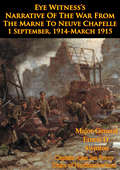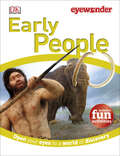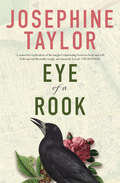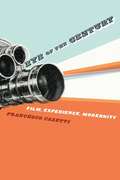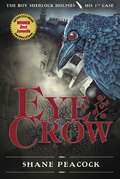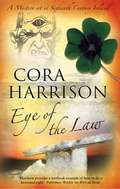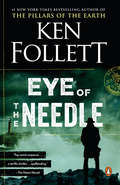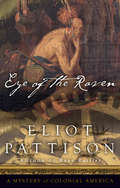- Table View
- List View
Extreme Scientists
by Donna M. JacksonThree scientists whose research entails physical danger are featured here: one flies into hurricanes; another explores caves; and the third climbs the world's tallest trees.
Extreme Survivors: Animals That Time Forgot (How Nature Works #0)
by Kimberly Ridley<p>Selected for the 2018 Bank Street College of Education Best STEM Children’s Books of the Year <p>What do the goblin shark, horseshoe crab, the “indestructible” water bear, and a handful of other bizarre animals have in common? <p>They are all “extreme survivors,” animals that still look much like their prehistoric ancestors from millions of years ago. <p>Meet ten amazing animals that appear to have changed little in more than 100 million years. They are the rare exceptions to the rule. <p>More than 99 percent of all life forms have gone extinct during the 3.6-billion-year history of life on Earth. Other organisms have changed dramatically, but not our extreme survivors. Evolution may have altered their physiology and behavior, but their body plans have stood the test of time. <p>How have these living links with Earth’s prehistoric past survived? The search for answers is leading scientists to new discoveries about the past—and future—of life on Earth. The survival secrets of some of these ancient creatures could lead to new medicines and treatments for disease. <p>Written in a lively, entertaining voice, Extreme Survivors provides detailed life histories and strange “survival secrets” of ten ancient animals and explains evolution and natural selection. Extensive back matter includes glossary, additional facts and geographic range for each organism and a geologic timeline of Earth. <p><B>F&P Level V </B> <P><P><i>Advisory: Bookshare has learned that this book offers only partial accessibility. We have kept it in the collection because it is useful for some of our members. To explore further access options with us, please contact us through the Book Quality link. Benetech is actively working on projects to improve accessibility issues such as these.</i>
Extreme Waves
by Craig B. SmithWaves are hypnotic and beautiful. They can also be great fun. But Hurricanes Katrina and Rita taught us that they can be powerful and deadly while the 2004 tsunami proved that some waves are absolutely devastating. Science is the best tool for understanding and predicting the most extreme waves. Where do waves come from? Why are some big and some small? From winter to summer, the nature of the beach changes, sculpted by the tireless energy of waves. Most waves are simply rhythmic expressions of Earth's movement through space and the changes they bring to our shorelines are gradual. But given the right weather conditions and combination of natural forces, waves can wreak havoc. These are extreme waves, waves that can stretch 100-feet high--posing an imminent threat to large sea vessels and coastal structures. There are even waves that have stripped trees from mountains as they surged to an estimated 1,700 feet high. But even smaller waves are dangerous to ships and coastlines. Indeed, the lessons of the 2004 Bay of Bengal tsunami and the damage wrought by recent tidal surges in New Orleans underscore the need for better tracking and prediction of extreme waves. Extreme Waves is a fascinating history of waves. Covering both the headline stories as well as incidents that are less well-known but equally startling Craig Smith, author and amateur sailor, will have you riveted from the first chapter to the last.
Extremely Loud: Sound as a Weapon
by Juliette Volcler&“Everything you ever suspected or feared about music as a weapon, sound as torture . . . Disturbingly illuminating in the possible ramifications&” (Kirkus Reviews). In this troubling and wide-ranging account, acclaimed journalist Juliette Volcler looks at the long history of efforts by military and police forces to deploy sound against enemies, criminals, and law-abiding citizens. During the 2004 battle over the Iraqi city of Fallujah, US Marines bolted large speakers to the roofs of their Humvees, blasting AC/DC, Eminem, and Metallica songs through the city&’s narrow streets as part of a targeted psychological operation against militants that has now become standard practice in American military operations in Afghanistan. In the historic center of Brussels, nausea-inducing sound waves are unleashed to prevent teenagers from lingering after hours. High-decibel, &“nonlethal&” sonic weapons have become the tools of choice for crowd control at major political demonstrations from Gaza to Wall Street and as a form of torture at Guantanamo and elsewhere. In an insidious merger of music, technology, and political repression, loud sound has emerged in the last decade as an unlikely mechanism for intimidating individuals as well as controlling large groups. &“Thorough and well researched,&” Extremely Loud documents and interrogates this little-known modern phenomenon, exposing it as a sinister threat to the peace and quiet that societies have traditionally craved (Publishers Weekly). &“Extremely Loud makes you shiver, or cover your ears, at the technological buildup now at the service of the most sophisticated forms of repression.&” —Libération
Extremely Violent Societies: Mass Violence in the Twentieth-Century World
by Christian GerlachIn this groundbreaking book Christian Gerlach traces the social roots of the extraordinary processes of human destruction involved in mass violence throughout the twentieth century. He argues that terms such as 'genocide' and 'ethnic cleansing' are too narrow to explain the diverse motives and interests that cause violence to spread in varying forms and intensities. From killings and expulsions to enforced hunger, collective rape, strategic bombing, forced labour and imprisonment he explores what happened before, during, and after periods of widespread bloodshed in countries such as Armenia, Indonesia, Bangladesh, Nazi-occupied Greece and in anti-guerilla wars worldwide in order to highlight the crucial role of socio-economic pressures in the generation of group conflicts. By focussing on why so many different people participated in or supported mass violence, and why different groups were victimized, he offers us a new way of understanding one of the most disturbing phenomena of our times.
Extremes: Life, Death and the Limits of the Human Body
by Kevin FongIn anaesthetist Dr Kevin Fong's television programmes he has often demonstrated the impact of extremes on the human body by using his own body as a 'guinea pig'. So Dr Fong is well placed to share his experience of the sheer audacity of medical practice at extreme physiological limits, where human life is balanced on a knife edge. Through gripping accounts of extraordinary events and pioneering medicine, Dr Fong explores how our body responds when tested by the extremes of heat and cold, vacuum and altitude, age and disease. He shows how science, technology and medicine have taken what was once lethal in the world and made it survivable. This is not only a book about medicine, but also about exploration in its broadest sense - and about how, by probing the very limits of our biology, we may ultimately return with a better appreciation of how our bodies work, of what life is, and what it means to be human.
Extremism, Radicalization and Security
by Julian RichardsThis book provides a detailed application of identity theory to contemporary questions of extremism, radicalization and security. The analysis considers how identity forms a central aspect of notions of extremism and security in Western societies, as articulated both by political leaders, the media and the government. It also takes a close and critical look at counter-extremism policy in contemporary Western society. With its detailed and empirical approach to these questions, this book is an accessible and invaluable resource for academics, practitioners, policy-makers and general readers keen to establish a deeper understanding of the key societal security threats of the day.
Extremists: Gadflies of American Society (Jules Archer History for Young Readers)
by Kathleen Krull Jules Archer“Extremism tends to flourish in times of crisis,” writes Jules Archer. It comes in all shapes and sizes and attaches itself to various causes. You can find extremism at the beginning with the founding fathers, extremists in the eyes of the British government and you can most definitely find it today. Jules Archer chronicles a history of extremists such as: Puritans,Suffragettes,The Klu Klux Klan,and Prohibitionists.With vintage cartoons and prints to further explain the subject, Jules Archer reports the fascinating history of protests in America.
Exvangelical and Beyond: How American Christianity Went Radical and the Movement That's Fighting Back
by Blake ChastainA pioneer of the &“exvangelical&” movement examines how toxic right-wing beliefs took over American Christianity—and why people are leaving the church and speaking out against itWith the rise of Trumpism, the American evangelical movement has more political influence than ever—yet at the same time, people are leaving Christianity in record numbers. Why are so many people walking away from the right-wing religion they were raised in, and what are they doing to overcome the past?Writer and podcaster Blake Chastain is uniquely positioned to understand this phenomenon. Raised evangelical, he went to a Christian college intending to become a pastor—until he found himself unable to reconcile his faith with the prejudice and even abuse he saw being done in God&’s name. He created the popular hashtag #exvangelical and the hit podcast of the same name, and soon became part of a growing movement of people walking away from toxic religion and using the unique tools of the internet to speak out, find healing, and build new communities.In Exvangelical and Beyond, Chastain delves into evangelicalism&’s deep roots in American politics and society, and explains why and how so many Christians—and ex-Christians—are forging a new path online. Blending history, personal narrative, and incisive analysis, this is a must-read for anyone who has left the church, is deconstructing their own faith, or simply wants to understand religious culture in America.
Eye Beyond the Sky: 27 Telescopes and Space Probes, from Hooker to JWST (Astronomers' Universe)
by Jie WangThis book highlights stories of the most important 13 ground-based observatories and 14 space probes in human history, leading readers through each significant step of human’s astronomical observation journey. From the earliest Hooker Telescope and the Mount Wilson Observatory, to the latest FAST, JWST and DAMPE, the targets of observation range from large systems such as the solar system, the milky way, and the universe, to individual planets such as Jupiter, Saturn, Mars, and the remote stars, and to the matters that reveal the origin of the universe, such as dark matter and cosmic background radiation. The book presents the mysteries of the sky in an easily readable manner suitable for audiences of all ages who are curious about the universe and thirsty to know all the important discoveries in the past century, especially the last decade. With carefully-selected contents, the book weaves together a series of tales to make the convoluted history of astronomical observation full offun and excitement, ensuring that readers never lose interest during reading.
Eye Contact: Photographing Indigenous Australians
by Jane LydonAn indigenous reservation in the colony of Victoria, Australia, the Coranderrk Aboriginal Station was a major site of cross-cultural contact the mid-nineteenth century and early twentieth. Coranderrk was located just outside Melbourne, and from its opening in the 1860s the colonial government commissioned many photographs of its Aboriginal residents. The photographs taken at Coranderrk Station circulated across the western world; they were mounted in exhibition displays and classified among other ethnographic "data" within museum collections. The immense Coranderrk photographic archive is the subject of this detailed, richly illustrated examination of the role of visual imagery in the colonial project. Offering close readings of the photographs in the context of Australian history and nineteenth- and early-twentieth-century photographic practice, Jane Lydon reveals how western society came to understand Aboriginal people through these images. At the same time, she demonstrates that the photos were not solely a tool of colonial exploitation. The residents of Coranderrk had a sophisticated understanding of how they were portrayed, and they became adept at manipulating their representations. Lydon shows how the photographic portrayals of the Aboriginal residents of Coranderrk changed over time, reflecting various ideas of the colonial mission--from humanitarianism to control to assimilation. In the early twentieth century, the images were used on stereotypical postcards circulated among the white population, showing what appeared to be compliant, transformed Aboriginal subjects. The station closed in 1924 and disappeared from public view until it was rediscovered by scholars years later. Aboriginal Australians purchased the station in 1998, and, as Lydon describes, today they are using the Coranderrk photographic archive in new ways, to identify family members and tell stories of their own.
Eye Mind
by Paul Drummond Julian Cope"One of the most exhilarating and important rock 'n' roll stories ever told."--Julian CopeThe trailblazing 13th Floor Elevators released the first "psychedelic" rock album in America, transforming culture throughout the 1960s and beyond. The Elevators followed their own spiritual cosmic agenda, to change society by finding a new path to enlightenment. Their battles with repressive authorities in Texas and their escape to San Francisco's embryonic counterculture are legendary.When the Elevators returned to Texas, the band became subject to investigation by Austin police. Lead singer Roky Erickson was forced into a real-life enactment of One Flew over the Cuckoo's Nest and was put away in a maximum-security unit for the criminally insane for years. Tommy Hall, their Svengali lyricist, lived in a cave. Guitarist Stacy Sutherland was imprisoned. The drummer was involuntarily subjected to electric shock treatments, and the bassist was drafted into the Vietnam War.This fascinating biography breaks decades of silence of band members and addresses a huge cult following of Elevators fans in the United States and Europe. The group is revered as a formative influence on Janis Joplin, Led Zeppelin, Patti Smith, Primal Scream, R.E.M, and Z.Z. Top.Roky Erickson is the subject of a heralded recent documentary feature, You're Gonna Miss Me; a box set of remastered Elevators CDs with liner notes by author Paul Drummond will be issued in fall 2007.
Eye Witness’s Narrative Of The War From The Marne To Neuve Chapelle 1 September, 1914-March 1915 [Illustrated Edition]
by Major-General Ernest D. Swinton Captain Alan Ian Percy Duke of NorthumberlandIncludes The First World War On The Western Front 1914-1915 Illustrations Pack with 101 maps, plans, and photos.Major-General Ernest Swinton had already had a long and illustrious career in the British Army before the advent of the First World War in 1914. Appointed as the official war correspondent by the war Minister Lord Kitchener in 1914, his reporting home was the only way for the British people to follow the war as journalists were at that time banned at the front. In these dispatches from the front Swinton told the public of the bloody fighting in Flanders and the heroic efforts of the Allies to stop the German Juggernaut. So even handed and realistic they were brought together in a series of books under the pseudonym "Eyewitness" for further publication. Swinton was not a "château" general by any means and visited the front with dangerous regularity write of the fighting with real authority, often including anecdotes of the ordinary soldiers that he interviewed. The miserable conditions and bloody siege warfare of the trenches left a lasting impression on him and he looked to a scientific solution to the muddy stalemate of the Western Front. He would gain lasting fame as the architect of the "tank" project that was to revolutionize warfare in the First World War and for many years thereafter.
Eye Wonder: Open Your Eyes to a World of Discovery (Eye Wonder)
by DKWhat was life like for early people before written records even began? Satisfy your child's curiosity about the lives of some of the first people with Eye Wonder: Early People. From the earliest human-like apes to the use of stone-age tools, from the discovery of fire to the dawn of agriculture and civilization, this book explores how the earliest people lived. This new addition features fun activities to help your child learn and remember the information in Eye Wonder: Early People. Visual learners and readers alike will love exploring and learning through Eye Wonder: Early People. These books are designed to teach through pictures and a visual approach, encouraging curiosity in young, school-age children. We've added games, activities, and quizzes to engage children even more — Eye Wonder: Early People activities are designed to teach kids to both remember more of what they've learned, and learn to research when they want to know more, teaching general study skills as well as knowledge about early people. Learn about science, history, and the natural world through beautiful photography and lively, age-appropriate text. The Eye Wonder series organizes information in a way that's easy to search, easy to read, and easy to learn.
Eye in the Sky
by Dwayne DayPresenting the full story of the CORONA spy satellites' origins, Eye in the Sky explores the Cold War technology and far-reaching effects of the satellites on foreign policy and national security. Arguing that satellite reconnaissance was key to shaping the course of the Cold War, the book documents breakthroughs in intelligence gathering and achievements in space technology that rival the landing on the moon.
Eye of a Rook
by Josephine TaylorIn 1860s London, Arthur sees his wife, Emily, suddenly struck down by a pain for which she can find no words, forced to endure harmful treatments and reliant on him for guidance. Meanwhile, in contemporary Perth, Alice, a writer, and her older husband, Duncan, find their marriage threatened as Alice investigates the history of hysteria, female sexuality and the treatment of the female body – her own and the bodies of those who came before.
Eye of the Beholder: Johannes Vermeer, Antoni van Leeuwenhoek, and the Reinvention of Seeing
by Laura J. SnyderThe remarkable story of how an artist and a scientist in seventeenth-century Holland transformed the way we see the world. On a summer day in 1674, in the small Dutch city of Delft, Antoni van Leeuwenhoek--a cloth salesman, local bureaucrat, and self-taught natural philosopher--gazed through a tiny lens set into a brass holder and discovered a never-before imagined world of microscopic life. At the same time, in a nearby attic, the painter Johannes Vermeer was using another optical device, a camera obscura, to experiment with light and create the most luminous pictures ever beheld. "See for yourself!" was the clarion call of the 1600s. Scientists peered at nature through microscopes and telescopes, making the discoveries in astronomy, physics, chemistry, and anatomy that ignited the Scientific Revolution. Artists investigated nature with lenses, mirrors, and camera obscuras, creating extraordinarily detailed paintings of flowers and insects, and scenes filled with realistic effects of light, shadow, and color. By extending the reach of sight the new optical instruments prompted the realization that there is more than meets the eye. But they also raised questions about how we see and what it means to see. In answering these questions, scientists and artists in Delft changed how we perceive the world. In Eye of the Beholder, Laura J. Snyder transports us to the streets, inns, and guildhalls of seventeenth-century Holland, where artists and scientists gathered, and to their studios and laboratories, where they mixed paints and prepared canvases, ground and polished lenses, examined and dissected insects and other animals, and invented the modern notion of seeing. With charm and narrative flair Snyder brings Vermeer and Van Leeuwenhoek--and the men and women around them--vividly to life. The story of these two geniuses and the transformation they engendered shows us why we see the world--and our place within it--as we do today.
Eye of the Century: Film, Experience, Modernity (Film and Culture Series)
by Francesco CasettiIs it true that film in the twentieth century experimented with vision more than any other art form? And what visions did it privilege? In this brilliant book, acclaimed film scholar Francesco Casetti situates the cinematic experience within discourses of twentieth-century modernity. He suggests that film defined a unique gaze, not only because it recorded many of the century's most important events, but also because it determined the manner in which they were received.Casetti begins by examining film's nature as a medium in an age obsessed with immediacy, nearness, and accessibility. He considers the myths and rituals cinema constructed on the screen and in the theater and how they provided new images and behaviors that responded to emerging concerns, ideas, and social orders. Film also succeeded in negotiating the different needs of modernity, comparing and uniting conflicting stimuli, providing answers in a world torn apart by conflict, and satisfying a desire for everydayness, as well as lightness, in people's lives. The ability to communicate, the power to inform, and the capacity to negotiate-these are the three factors that defined film's function and outlook and made the medium a relevant and vital art form of its time.So what kind of gaze did film create? Film cultivated a personal gaze, intimately tied to the emergence of point of view, but also able to restore the immediacy of the real; a complex gaze, in which reality and imagination were combined; a piercing gaze, achieved by machine, and yet deeply anthropomorphic; an excited gaze, rich in perceptive stimuli, but also attentive to the spectator's orientation; and an immersive gaze, which gave the impression of being inside the seen world while also maintaining a sense of distance. Each of these gazes combined two different qualities and balanced them. The result was an ever inventive synthesis that strived to bring about true compromises without ever sacrificing the complexity of contradiction. As Casetti demonstrates, film proposed a vision that, in making opposites permeable, modeled itself on an oxymoronic principle. In this sense, film is the key to reading and understanding the modern experience.
Eye of the Crow: His 1st Case) (The Boy Sherlock Holmes #1)
by Shane PeacockSherlock Holmes, just thirteen, is a misfit. His highborn mother is the daughter of an aristocratic family, his father a poor Jew. Their marriage flouts tradition and makes them social pariahs in the London of the 1860s; and their son, Sherlock, bears the burden of their rebellion. Friendless, bullied at school, he belongs nowhere and has only his wits to help him make his way.But what wits they are! His keen powers of observation are already apparent, though he is still a boy. He loves to amuse himself by constructing histories from the smallest detail for everyone he meets. Partly for fun, he focuses his attention on a sensational murder to see if he can solve it. But his game turns deadly serious when he finds himself the accused -- and in London, they hang boys of thirteen.Shane Peacock has created a boy who bears all the seeds of the character who has mesmerized millions: the relentless eye, the sense of justice, and the complex ego. The boy Sherlock Holmes is a fascinating character who is sure to become a fast favorite with young readers everywhere.From the Hardcover edition.
Eye of the Fish
by Luis H. FranciaThe first of Luis H. Francia's books of non-fiction to be published in the United States, The Eye of the Fish paints a vivid and detailed portrait of the terror, beauty and insistent humanity of the Philippines of today. <p><p> Cross-cutting between Francia's recollections of the Philippines of his youth and accounts of his travels through the archipelago over the past two decades, The Eye of the Fish takes us the length of the nation: from Batanes in the north to the Muslim Jolo and Marawi regions of the south, and from the rugged mountain hideaways of revolutionary freedom fighters to the well-appointed salons of the political and cultural elite. Painters and priests, island shamans and small-town politicians, cultists, feminists and infamous first ladies all make an appearance in this imaginative and idiosyncratic exploration of 'home.' <p> Through their stories, and through his own memories of estrangement and acceptance in the Philippines and in the U.S., Francia reflects on the hybridity that is simultaneously the burden and the benediction of the Philippines--and of his own mestizo self.
Eye of the Hawk
by David William RossIN THE SPELLBINDING TRADITION OF LONESOME DOVE AND STREETS OF LAREDO A MAGNIFICENT SAGA OF LIFE AND DEATH IN THE LONE STAR REPUBLIC It was a harsh and inhospitable land, claimed by many yet owned by none. Here Comanche and Kiowa joined together in terror and brutality to halt a young nation's relentless march westward...dangerous banditos roamed open plains...and runaway slaves reached for freedom. And it was here that Seth Redmond brought his wife Isabelle to raise a family and to build a dream called Thunder Run-a dream that would endure through two generations of cruelty, lust, betrayal and dark secrets ... and the crazed blood vengeance of a fearsome warrior chief.
Eye of the Law: A Mystery of Medieval Ireland (Burren Mysteries #5)
by Cora HarrisonA Mystery of Medieval Ireland--1510. A great feast is being held. Into a crowd listening to the story of Balor, the one-eyed god, come two strangers. The younger of the two, Iarla, bears a letter that claims that the wealthy Ardal O'Lochlainn is his true father--which Ardal vociferously denies. So when Iarla is found dead, with one eye missing, some think he was killed by the god--but most suspect Ardal. Mara, the Brehon--or lawgiver--of the Burren, is called to investigate.
Eye of the Moon
by Dianne HofmeyrIsikara and her father tend the sacred crocodiles and assist at mummifications of both humans and animals. One day, they are ordered to a tomb. Two bodies are waiting for them--Queen Tiy and her eldest son, Tuthmosis. Tuthmosis has been poisoned but is clinging to life. With no time to spare, Isikara rescues the young prince and runs away with him. The pair find themselves on a journey across Egypt, searching for allies who will help Tuthmosis regain his throne. Their travels lead them along the Nile, across the desert, and through bustling market towns. All the while they must avoid their pursuers, the High Priests who wish to silence them. But there are dangers in the desert and all around. Who can they trust? And where will their adventure lead them? In this gripping tale, published for the first time in the U.S., author Dianne Hofmeyr spins a web of intrigue, mystery and adventure, woven throughout with fascinating historical details about Ancient Egypt.
Eye of the Needle: A Novel
by Ken FollettThe worldwide phenomenon from the author of Edge of Eternity.His code name was "The Needle." He was a German aristocrat of extraordinary intelligence--a master spy with a legacy of violence in his blood, and the object of the most desperate manhunt in history.... But his fate lay in the hands of a young and vulnerable English woman, whose loyalty, if swayed, would assure his freedom--and win the war for the Nazis....From the Paperback edition.
Eye of the Raven: A Mystery of Colonial America (The Mystery of Colonial America Series #2)
by Eliot PattisonWith the aid of the Indian Shaman Conawago, Duncan McCallum has begun to heal from the massacre of his Highland clan by the British. But his new life is shattered when he and Conawago discover a dying Virginian officer nailed to an Indian shrine tree. To their horror, the authorities arrest Conawago and schedule his hanging. As Duncan begins a desperate search for the truth, he finds himself in a maelstrom of deception and violence. The year is 1760, and while the British army wishes to dismiss the killing as another casualty of its war with France, Duncan discovers a pattern of ritualistic murders that have less to do with the war than with provincial treaty negotiations and struggles between tribal factions. Ultimately he realizes that to find justice, he must brave the sprawling colonial capital of Philadelphia. There the answers are to be found in a tangle of Quakers, Christian Indians, and a scientist obsessed with the electrical experiments of the celebrated Dr. Franklin. With the tragic resolution in sight, Duncan understands the real mysteries underlying his quest lie in the hearts of natives who, like his Highland Scots, have glimpsed the end of their world approaching.

